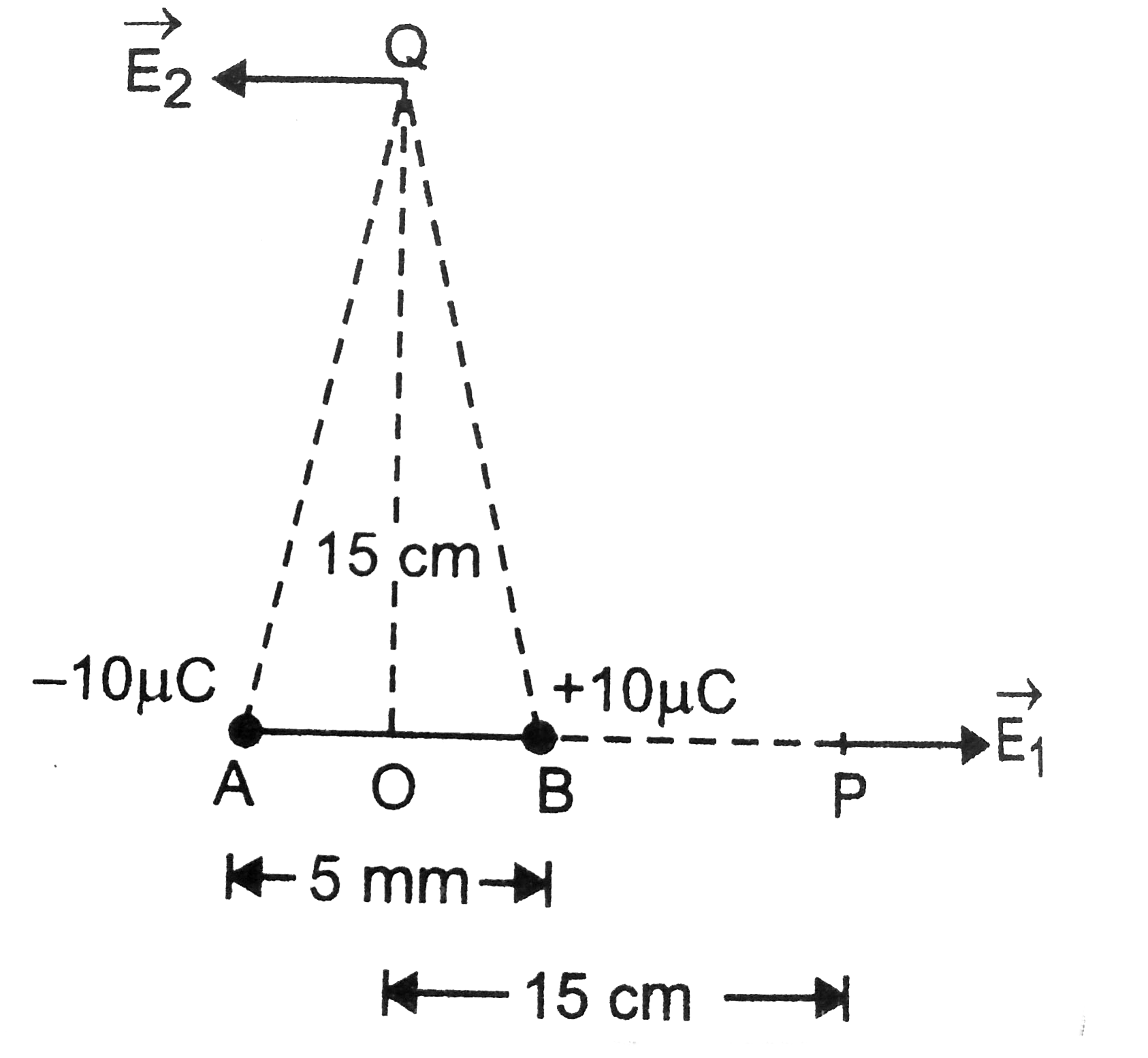Two charges ±10μC are placed 5⋅0mm apart. Determine the electric field at (a) point P on the axis of dipole 15cm away from its center on the side of the positive charge. As shown in Figure and at (b) a point Q. 15cm away form O on a line passing through O and a line passing through O and normal to the axis of the dipole as shown in Fig.

(a) Field at P due to charge +10μC
=108C4π(8.854×10−12C2N−1m−2)×1(15−0.25)3×10−4m3
=4.13×108NC−1along BP
Field at P due to charge −10μC
=108C4π(8.854×10−12C2N−1m−2)×1(15−0.25)3×10−4m3
The resultant electric field at P due to the two charges at A and B is
=2.7×105NC−1along BP.
In this example, the ratio OP/OB is quite large (= 60). Thus, we canexpect to get approximately the same result as above by directly usingthe formula for electric field at a far-away point on the axis of a dipole.For a dipole consisting of charges ± q, 2a distance apart, the electricfield at a distance r from the centre on the axis of the dipole has amagnitude
E=24πε0r3 (r/a>>1)
where p = 2a q is the magnitude of the dipole moment. The direction of electric field on the dipole axis is always along thedirection of the dipole moment vector (i.e., from –q to q).
Here,p=10−5C×5×10−3m=5×10−8Cm
Therefore
=108C4π(8.854×10−12C2N−1m−2)×1(15)3×10−4m3=2.6×105NC−1
along the dipole moment direction AB, which is close to the result obtained earlier.
(b) Field at Q due to charge +10μCatB
=105C4π(8.854×10−12C2N−1m−2)×1[152−(0.25)3]×10−4m2
=3.99×106NC−1along BQ ltBRgt Field at Q due to charge −10μCatA
=108C4π(8.854×10−12C2N−1m−2)×1[152−(0.25)3]×10−4m3
=3.99×106NC−1along QA.
Clearly, the components of these two forces with equal magnitudes cancel along the direction OQ but add up along the direction parallel to BA. Therefore, the resultant electric field at Q due to the two charges at A and B is =2×0.25√152+(0.25)2=3.99×106NC−1along BA
1.33×105NC−1along BAAs in (a), we can expect to get approximately the same result by directly using the formula for dipole field at a point on the normal to the axis of the dipole:
E=P4πε0r3 (r/a>>1)
=5×108Cm4π(8.854×10−12C2N−1m−2)×1(15)3×10−6m3
=1.33×105NC−1
The direction of electric field in this case is opposite to the direction of the dipole moment vector. Again, the result agrees with that obtained before.
Topper's Solved these Questions
- BOOK - NCERTCHAPTER - ELECTRIC CHARGES AND FIELDSEXERCISE - EXERCISE34videos
ELECTRIC CHARGES AND FIELDS
- BOOK - NCERTCHAPTER - DUAL NATURE OF RADIATION AND MATTEREXERCISE - Exercise37videos
DUAL NATURE OF RADIATION AND MATTER
- BOOK - NCERTCHAPTER - ELECTROMAGNETIC INDUCTIONEXERCISE - Exercise17videos
ELECTROMAGNETIC INDUCTION
Similar Questions
Two charges ±10μC are placed 5⋅0mm apart. Determine the electric field at (a) point P on the axis of dipole 15cm away from its center on the side of the positive charge. As shown in Figure and at (b) a point Q. 15cm away form O on a line passing through O and a line passing through O and normal to the axis of the dipole as shown in Fig.
 View Solution
View SolutionTwo charges +20μCand−20μC are placed 10mm apart. The electric field at point P, on the axis of the dipole 10 cm away from its centre O on the side of the positive charge is
 View Solution
View Solution
Knowledge Check
- Question 1 - Select One
Two charges +5μC and +10μC are placed 20cm apart. The net electric field at the mid-point between the two charges is
A4.5×106N/C directed towards +5μCB4.5×106N/C directed towards +10μCC13.5×106N/C directed towards +5μCD13.5×106N/C directed towards +10μC - Question 2 - Select One
Two charges 4q and q are placed 30 cm. apart. At what point the value of electric field will be zero
A10 cm. away from q and between the chargeB20 cm. away from q and between the chargeC10 cm. away from q and out side the line joining the charge.D10 cm. away from 4q and out side the line joining them. - Question 3 - Select One
Two charges 4q and q are placed 30 cm. apart. At what point the value of electric field will be zero
A10 cm away from q and between the chargesB20 cm away from q and between the chargesC10 cm away from q and outside the line joining the chargesD10 cm away from 4q and outside the line joining them
Two charges ±10μC are placed 5×10−3m apart. Determine the electric field at a point Q,0⋅15m away from O, on a line passing through O and normal to the axis of the diople.
View SolutionTwo charges +20μCand−20μC are held 1cm apart. Calculate the electric field at a point on the equatorial line at a distance of 50cm from the center of the dipole.
View SolutionTwo charges +30μCand−30μC are placed 1cm apart. Calculate electric field at a point on the axial line at a distance of 20cm from the centre of dipole.
View SolutionTwo charges +20μC and −20μC are 5 mm apart. Find the electric field on axial as well as on the equatorial line at a distance 20 cm from the mid -point of the dipole.
View SolutionTwo charges +0.2μμCand−0.2μμC are placed 10−6cm apart. Calculate electric field at an axial point at a distance of 10 cm from their middle point.
View Solution

